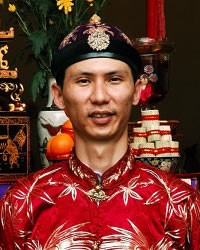The Baba Chinese are the descendants of Chinese immigrants that settled in Peninsula Malaysia, primarily in and around the state of Malacca as early as the 17th century. Intermarriage with the native peoples of the region was common and engendered a unique culture that combined various customs and traditions. Baba Chinese identity and culture became distinct in the 19th century before the British rule, when large numbers of Chinese immigrated to Malaysia. Local Malay people first used honorific terms like Baba to address the men, Nyonya for women, and Bibik for elderly ladies. The most distinct aspect of Baba culture today is their language called Baba Malay. It is a song-like language influenced by Hokkien accents and contains loanwords from Malay, Indonesian, and English. The majority of the Baba Chinese live in the state of Malacca but some are also found in Penang and Singapore. They settled in both urban and rural areas but are concentrated in the Central Malacca District.
The Baba Chinese had their time of greatest success, prosperity, and power during the 19th and early 20th centuries. They were the dominant Chinese businessmen and leaders of the Chinese communities. Baba businessmen and leaders could speak English and therefore enjoyed cordial relationships with the European rulers. They, therefore, led very illustrious careers and commanded a lot of respect in the field of business, the arts, and government. Many are still middle-income salaried bureaucrats because of their close association with current Malaysian culture. The architectural style of Baba homes is very unique, being a fusion of Eastern and Western designs. There are still some Baba homes and buildings in Penang and Malacca.
A typical Baba house has a first living hall for visitors and an adjacent area for the unmarried Nyonya to congregate, one or two courtyards, bedrooms, bridal chamber, and kitchen.
Most of the Baba adhere to ancestral Chinese religion but a quarter of them are Roman Catholics. They, especially the older generation, observe traditional Chinese religious beliefs and rituals. They worship ancestors and pray to Chinese deities. They celebrate Chinese festivals like the Lunar Chinese New Year and Moon Cake festival on a large scale. In general, their religious beliefs and practices are similar to other Malaysian Chinese, although there are relatively more Baba who worship at the graves of Muslim saints called Keramat. In Singapore a significant numbers of Baba Chinese are Christians.
Although there are many middle-income salaried Baba, this does not mean that the entire Baba society is rich. There are those who are striving in business and others who are trying to get out of the poverty cycle - they need any help possible. Pray that these Baba will be successful in their quest to meet financial needs. Pray also that God will call committed followers who are able to relate and respond to the needs of the Baba Chinese.
Pray for hundreds to be raised up with a defiant faith in Christ, one that will not be shaken no matter what comes their way.
Pray for God to bring about his purpose for the Baba Creole Straits Chinese people.
Pray for Christians to have love, joy, peace, and patience as they tell others about the King of kings.
Pray for a powerful Holy Spirit revival to permeate their families and churches, drawing them into greater love for God and for their neighbors.
Scripture Prayers for the Straits Chinese, Baba Creole in Singapore.
Southeast Asia Link - SEALINK Copyrighted © Used with permission.
| Profile Source: Joshua Project |










